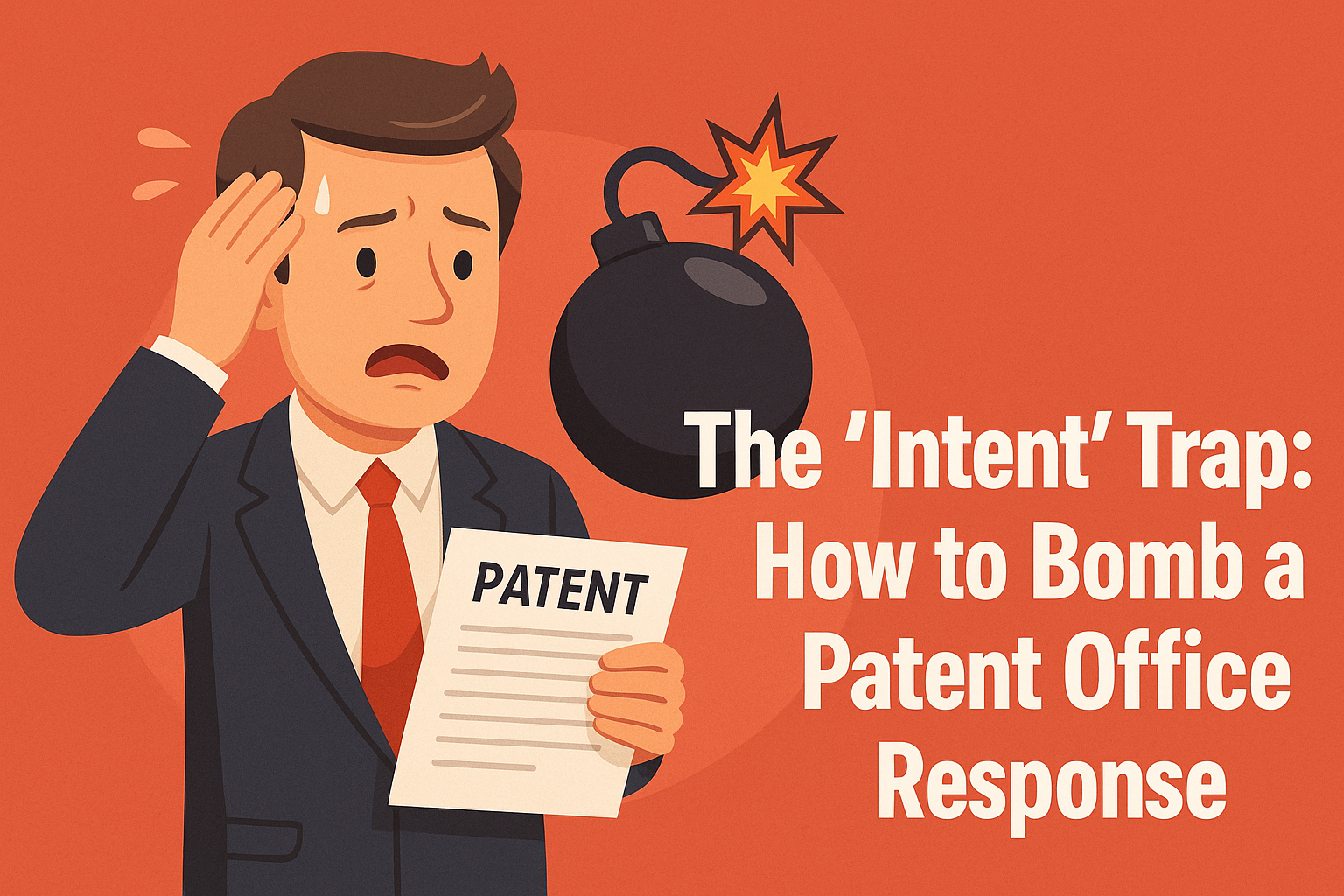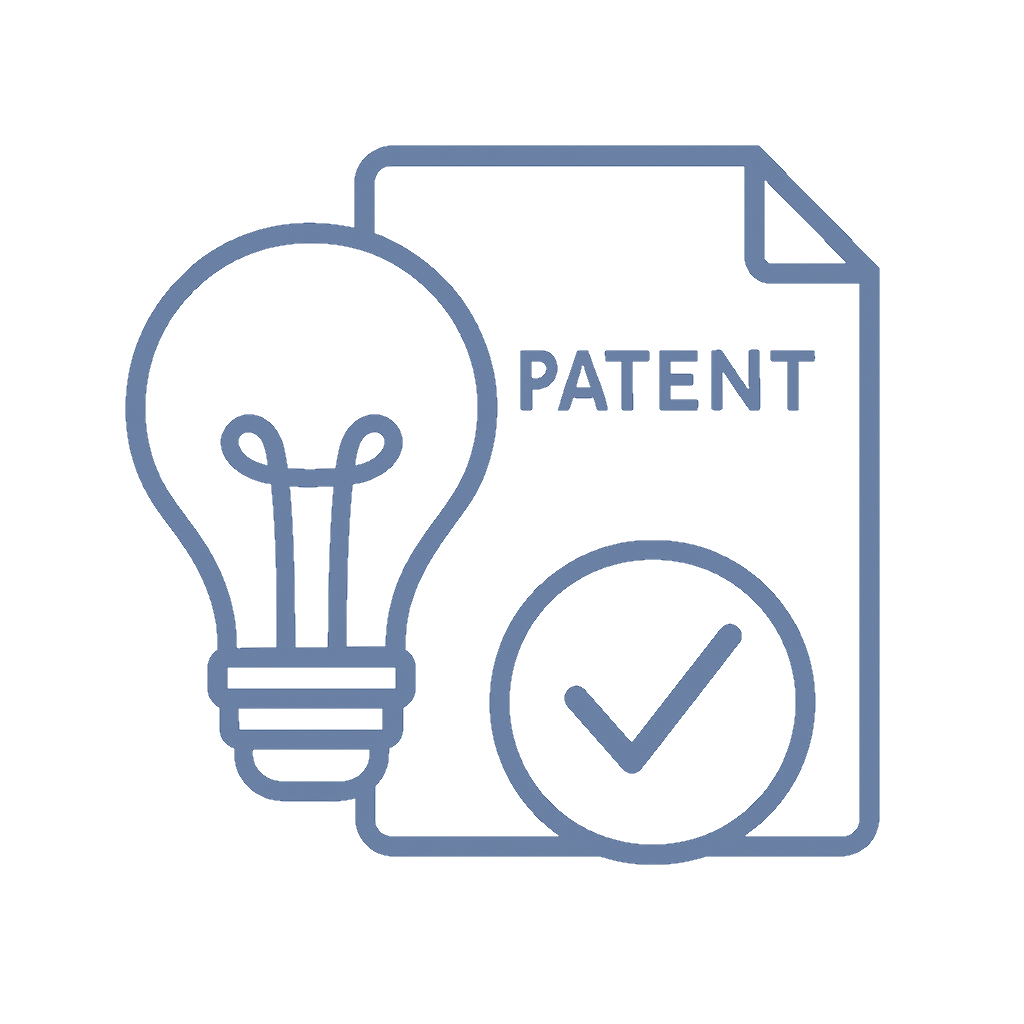📌 Quick Summary
1-Sentence Answer:
Saying the prior inventor didn’t “intend” your use is not a valid patent office response—structure or method overlap is what actually matters.
The Article Overview:
This article unpacks a common patent prosecution pitfall: arguing that a prior invention wasn’t meant for your purpose. We’ll explore why “intent” doesn’t matter in patent law, what does, and how to avoid tanking your response to an office action.

❓ Common Questions & Answers
Q1: Why doesn’t the original inventor’s intent matter in patent law?
Because patentability is judged by the claimed invention’s structure or method—not what the original inventor had in mind when creating it.
Q2: What’s a better approach than citing “intent”?
Focus on structural or functional distinctions between your invention and the cited prior art, especially in claim language.
Q3: Can accidental overlaps in function hurt my patent claim?
Absolutely. If your invention performs similarly or is structurally identical, intent won’t save you from rejection under §§ 102 or 103.
Q4: What’s the biggest mistake inventors make in office action responses?
Relying on subjective reasoning like intent or commercial success rather than objective claim differences.
Q5: Is “intended use” ever relevant?
Rarely. It may matter for method claims or user interactions, but for apparatus claims, it usually holds no weight.
📜 Step-by-Step Guide
Step 1: Read the office action carefully.
Identify which claims are being rejected and under which statute—102 (novelty) or 103 (obviousness).
Step 2: Examine the cited prior art.
Study its structure or method. Ignore what it was meant to do—focus on what it actually discloses.
Step 3: Compare structural elements.
Does your claim include unique structural features not found in the prior art? Highlight those.
Step 4: Draft a claim-by-claim rebuttal.
Be specific. Use clear, technical language to contrast your invention with the cited reference.
Step 5: Avoid subjective arguments.
Don’t say “it wasn’t meant for that.” Instead, explain how your claimed invention is novel and non-obvious.
📖 Historical Context
Patent law, from its roots in the U.S. Constitution to the modern USPTO Manual of Patent Examining Procedure (MPEP), is rooted in objectivity. A claim is granted based on whether it meets statutory requirements—not whether the applicant has a noble purpose or the cited inventor had something else in mind.
Courts have long established that intended use doesn’t define patentability. One of the earliest clarifications came in In re Schreiber (1997), where a prior art dispenser was deemed to anticipate a claimed invention—even though it was used for popcorn, not oil. The takeaway? If it quacks like prior art, it is prior art.
The problem arises when inventors treat the patent process like a marketing pitch. What matters isn’t why something was built, but what it is. Legal precedents confirm: the structure trumps the story every time.
🏢 Business Competition Examples
-
Dyson vs. Hoover – Dyson's unique vacuum technology faced prior art challenges. Their winning strategy? Highlighting structural cyclone separation differences—not arguing that Hoover didn’t “mean” to clean like them.
-
Apple vs. Samsung – In various lawsuits, Apple focused on claim-specific design patents and interface methods. They never leaned on “intent,” knowing the courts didn’t care what Samsung “meant.”
-
Theranos – Though not a positive example, Theranos attempted to pivot patent claims based on intended diagnostic use. These arguments collapsed under scrutiny when the technology’s actual function didn’t match the claims.
-
3M’s N95 Patent Defense – 3M defended its patents not on usage purpose, but on the specifics of the filtration layers and sealing structure—technical, not philosophical.

💬 Discussion Section
Let’s dig into the seductive but dangerous world of the “intent” trap in patent law. Many inventors—and even some inexperienced attorneys—get caught in the emotional logic that, “My invention is different because it was meant for X, not Y.” But patent examiners aren’t therapists. They’re legal technicians trained to identify claim language, structure, and functionality. They don’t care if your gadget was supposed to change lives—they care if it’s legally distinguishable.
The reason intent falls flat is simple: patent law doesn’t hinge on motivation. If someone created a widget that happens to do what yours does—even if for a totally different reason—it counts. This is especially true for apparatus claims, which are judged on what the structure can do, not what the inventor meant for it to do.
Arguing intent is like arguing with a speed camera that you meant to slow down. It doesn’t matter. You were still going 50 in a 30. Likewise, if your invention overlaps structurally with prior art—even accidentally—it’s legally relevant.
The right path? Demonstrate technical differences. Adjust your claims. Highlight what’s new in your design or process. Save the origin story for TED Talks—not for overcoming rejections.
⚖️ The Debate
💥 Argument For Using “Intent”:
It can humanize the invention and sometimes help examiners understand commercial context or user interaction, especially in method claims. It may aid in brand storytelling, even if it doesn’t win the legal point.
🧊 Argument Against Using “Intent”:
Intent doesn’t alter the fact that an apparatus or method exists in the prior art. Courts and examiners are bound by claim language and precedent, not personal narratives.
✅ Key Takeaways
-
Patent law is structure-first, story-last.
-
Examiner rejections focus on what’s disclosed—not what was intended.
-
Use technical distinctions in claims, not emotional reasoning.
-
Apparatus claims rarely benefit from intended use arguments.
-
Avoid soft arguments—they burn time and credibility.

⚠️ Potential Business Hazards
-
Delayed patent grant due to weak office action responses
-
Increased legal fees from unnecessary back-and-forth
-
Loss of competitive advantage if claims are narrowed poorly
-
Patent rejection due to unpersuasive claim arguments
❌ Myths & Misconceptions
-
“Intent defines invention” – Nope. Structure and function do.
-
“Examiners consider purpose” – Only when the claims require it.
-
“Marketing angle helps in legal arguments” – Not in prosecution.
-
“If it’s used differently, it’s new” – Not if structure is the same.
-
“I can argue my way out with intent” – Only if your claims are rock-solid.
📚 Book & Podcast Recommendations
-
Patent It Yourself by David Pressman – https://www.nolo.com/products/patent-it-yourself-pat.html
-
Landmark Patents podcast – https://landmarkpatents.buzzsprout.com/
-
IP Fridays podcast – https://www.ipfridays.com/
-
Essentials of Patents by Stephen Key – https://www.amazon.com/Essentials-Patents-Alexander-I-Poltorak/dp/0471479150
⚖️ Legal Cases
-
In re Schreiber (1997) – https://caselaw.findlaw.com/court/us-federal-circuit/1268644.html
(Popcorn dispenser case confirms structure beats intent.) -
Application of Yanush (1971) – https://caselaw.findlaw.com/court/us-court-of-customs-and-patent-appeals/939888.html
(Confirms functional similarity defeats argument about intended use.) -
General Electric Co. v. Jewel Inc. – https://casetext.com/case/gen-electric-co-v-jewel-inc
(Highlights failure of intended-use-only distinctions.)
📣 Expert Invitation
Think your patent arguments could use a tune-up? Visit http://inventiveunicorn.com and book a free consultation with our legal strategy team. Don’t go down the “intent” rabbit hole alone—get pro-level help before your next office action!

🔚 Wrap-Up Conclusion
Patent law isn’t interested in your feelings—it’s interested in your claims. Don’t bomb your next office action response with “intent” talk. Stick to the facts, own your structure, and win your patent like a pro.












